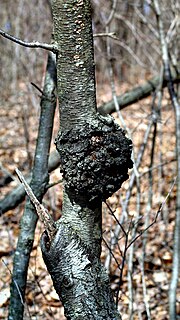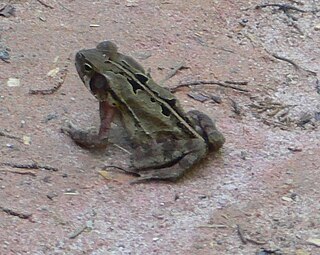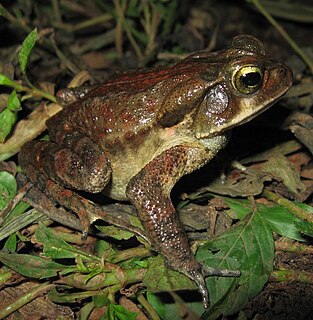
The spring peeper is a small chorus frog widespread throughout the eastern United States and Canada. They are so called because of their chirping call that marks the beginning of spring. There are two subspecies:

A crucifer or cross-bearer is, in some Christian churches, a person appointed to carry the church's processional cross, a cross or crucifix with a long staff, during processions at the beginning and end of the service.

Barbarea is a genus of about 22 species of flowering plants in the family Brassicaceae, native to temperate regions of the Northern Hemisphere, with the highest species diversity in southern Europe and southwest Asia. They are small herbaceous biennial or perennial plants with dark green, deeply lobed leaves and yellow flowers with four petals.
Paul Giovanni was an American playwright, actor, director, singer and musician. Giovanni is best known for writing the music for the 1973 British horror film The Wicker Man.
Fraser Clarke Heston is an American film director, film producer, screenwriter and actor. He is the son of actors Charlton Heston and Lydia Clarke, and has a sister, Holly Rochell Heston.

Barbarea vulgaris, also called bittercress, herb barbara, rocketcress, yellow rocketcress, winter rocket, yellow rocket, and wound rocket, is a biennial herb of the genus Barbarea, belonging to the family Brassicaceae.

Black rot is a name used for various diseases of cultivated plants caused by fungi or bacteria, producing dark brown discoloration and decay in the leaves of fruit and vegetables:

Rhinella crucifer is a species of toad in the family Bufonidae. It endemic to Brazil and known from the Atlantic Forest of eastern Brazil between the states of Ceará in the north and Rio de Janeiro in the south. Common name striped toad has been coined for it. "Rhinella pombali" is a hybrid between Rhinella ornata and this species.

Rhinella pombali is a hybrid species of toad from south-eastern Brazil, named after José Perez Pombal, Jr., a Brazilian herpetologist. It was originally described in 2004 as a distinct species, but a genetic study published in 2012 found it to be a hybrid of Rhinella ornata and Rhinella crucifer; it is also morphologically intermediate between these species. It is therefore no longer considered a valid species, although it is still present in some listings.

Pristimantis crucifer is a species of frog in the family Craugastoridae. It is endemic to Ecuador. Its natural habitats are tropical moist montane forests and rivers. It is threatened by habitat loss.

A processional cross is a crucifix or cross which is carried in Christian processions. Such crosses have a long history: the Gregorian mission of Saint Augustine of Canterbury to England carried one before them "like a standard", according to Bede. Other sources suggest that all churches were expected to possess one. They became detachable from their staffs, so that the earliest altar crosses were processional crosses placed on a stand at the end of the procession. In large churches the "crux gemmata", or richly jewelled cross in precious metal, was the preferred style. Notable early examples include the Cross of Justin II, Cross of Lothair, and Cross of Cong.

The Crucifer of Blood is a play by Paul Giovanni that is adapted from the Arthur Conan Doyle novel The Sign of the Four. It depicts the character Irene St. Claire hiring the detective Sherlock Holmes to investigate the travails that her father and his three compatriots suffered over a pact made over a cursed treasure chest in colonial India during the Indian Rebellion of 1857.
Cardus crucifer is a species of blind deep-water decapod crustacean from the Atlantic Ocean, the only species in the genus Cardus. It differs from other members of the family Polychelidae in having only four pairs of claws, instead of five, in both sexes. The name Cardus refers to the thistle Carduus, in reference to the spiny thistle-like carapace. It is found in the eastern Atlantic from Portugal to Morocco and around the Azores and Canary Islands, and in the Bahamas, the Caribbean Sea and the Gulf of Mexico, at depths of 550–2,200 metres (1,800–7,220 ft).

Phymanthus crucifer, commonly known as rock flower anemone, flower anemone, red beaded anemone or the beaded anemone, is a species of sea anemone in the family Phymanthidae. It has been described as "closely similar" to Heteractis aurora in several ways, commonly exhibiting "tentacles with swollen cross-bars" bearing large clusters of stinging nematocysts. However, P. crucifer may also be found with smooth tentacles, sometimes in the immediate vicinity of a swollen-crossbarred specimen.

Crucifer is an unincorporated community in Henderson County, Tennessee, United States.
Spilotragus is a genus of longhorn beetles of the subfamily Lamiinae, containing the following species:
Spilotragus clarkei is a species of beetle in the family Cerambycidae. It was described by Stephan von Breuning in 1976.
Spilotragus xanthus is a species of beetle in the family Cerambycidae. It was described by Karl Jordan in 1903. It is known from Mozambique and the Democratic Republic of the Congo.
Pristurus crucifer, also known commonly as the cross-marked semaphore gecko or Valenciennes rock gecko, is a species of lizard in the family Sphaerodactylidae. The species is native to eastern Africa and western Asia.












